Homeschooling Statistics 2025
reviewed by Jo-ann Caballes
Updated on October 27, 2025
What is best for your child – public school or homeschooling? I know it’s a difficult choice to make because there are advantages/disadvantages to each type of education.
In this article, you’ll find main statistics about homeschooling, about how many homeschoolers in the US, as well as comparative statistics about public school vs homeschool statistics. This will help you review all the essential indicators for homeschooling, and make the right choice.
Note: Before making the switch to full-time homeschooling, it is important to know your state’s legal requirements. Some states have minimal or zero requirements, while others may ask for standardized testing or a portfolio review. Whatever the case, understanding the legal position will make your transition to a new educational system easier.
How many parents homeschool in the US
Parents of more than 3.7 million children in the United States in 2025 are homeschooling, either partially or fully.
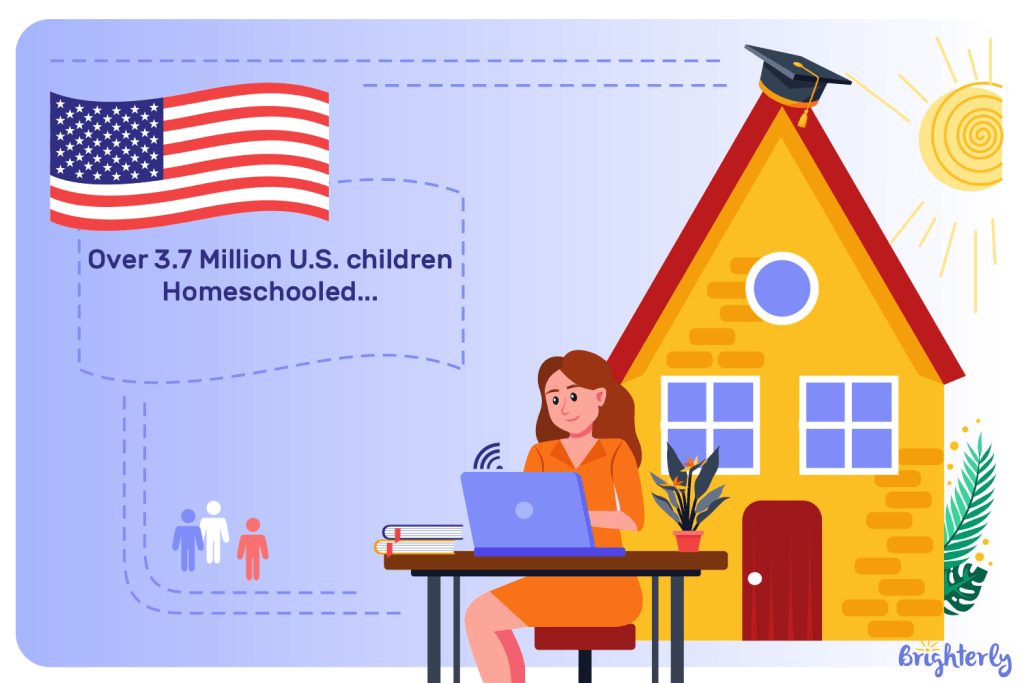
Why parents choose homeschooling with tutoring platforms (Statictics)
Parents opt for homeschooling with tutoring platforms because they believe their child can benefit from individualized teaching or alternative curriculums. Approximately 72% of homeschooling parents express dissatisfaction with the academic quality of traditional schools.

For example, Brighterly reading and math tutors can convey more knowledge to children than is typically possible in traditional public schools. This is because, unlike in conventional classrooms where a teacher must divide their attention among many students, Brighterly provides one-on-one interactive online lessons, ensuring each student receives the maximum amount of personalized attention.
Thousands of parents choose homeschooling in the USA with Brighterly reading and math platform because each tutor is carefully selected based on the student’s grade, knowledge level, goals, and specific needs, such as ADHD or dyslexia.
Each Brighterly private math tutor or reading tutor develops a personalized reading or math program based on a student’s strengths and areas for improvement. They carefully monitor each child’s progress to ensure that by the end of the course, your kid not only enjoys the subject but also possesses the necessary knowledge for their age level.
Check out our reading class or math class offerings for more structured learning experiences.
Homeschooling statistics vs Public schooling statistics
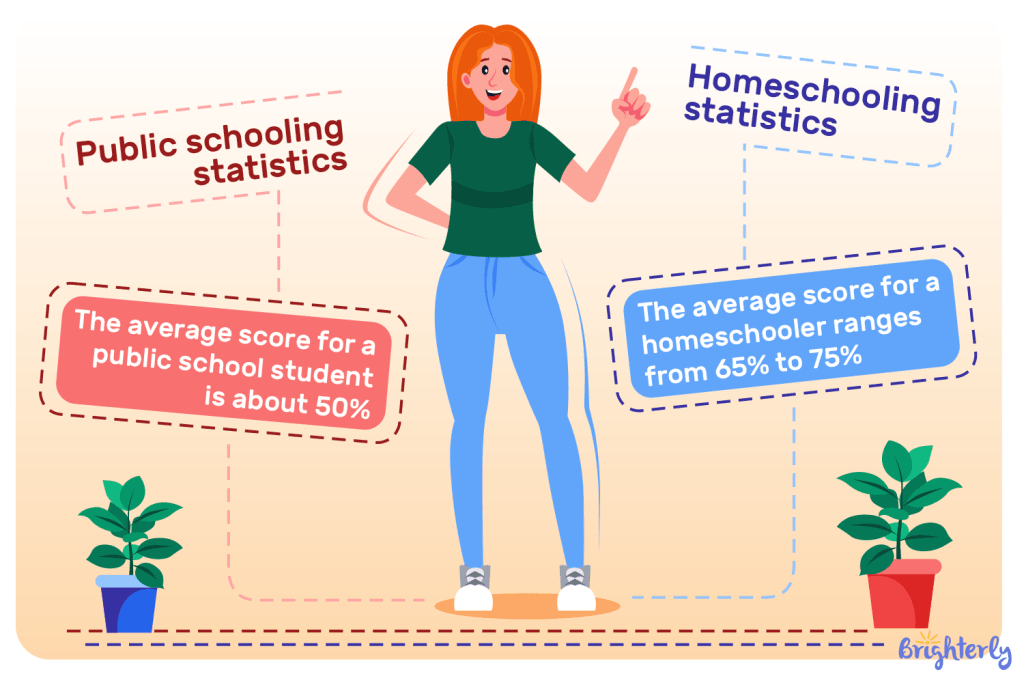
Below, you’ll find out more about why so many children in the United States in 2025 are homeschooled, what benefits their parents see, and why they refuse public schooling.
Homeschooling vs Public Schooling Statistics |
|
Positive homeschooling statistics |
Only public schooling |
| Higher academic performance. The average score for a homeschooler ranges from 65% to 75% (scores range from 1 to 99). | Lower academic scores. The average score for a public school student is about 50% (scores range from 1 to 99). |
|
Personalized learning that motivates children. According to the NHERI (National Home Education Research Institute) homeschool statistics, a clear advantage of homeschooling is the ability to adapt learning to each child. |
Such schools generally don’t have the advantage of personalization, and in addition, children in public schools may be exposed to negative peer behavior. 1 out of 5 students between the ages of 12 and 18 are bullied every year. |
|
About 15% of parents prefer homeschooling because their kid has a feeling of dissatisfaction with the academic instruction in the regular education system. At home, you can control and adjust the curriculum, choose your tutors, teach, and do everything to ensure your child learns in the best way. |
The quality of the information provided may vary across public schools, including due to budget, location, etc. Many countries are not spending enough on education and because of this, many children cannot get a quality education. |
| According to data from Skillademia, more than 74% of parents choose homeschooling because they want religious or moral education. | IES and NCES state that 25% of parents said safety was the primary motivation behind their decision to homeschool. |
General homeschooling statistics around the world
In this section, we’ll explore the critical homeschooling statistics 2020 – 2025 every parent needs to know:
- According to 2023 data from NHERI, more than 9 million American schoolers of all ages have been homeschooled at least once.
- The COVID-19 pandemic led to the homeschooling of more than 300 million students: During the pandemic, many parents were forced to take their children’s education into their hands, which led to a tremendous spike in the number of homeschooled students.
- 98% of homeschooled students participate in an average of 5 extracurriculars per week: Studies have shown that homeschooled students are more likely to participate in extracurricular activities than their peers in traditional schools. Thus, a large percentage of kids homeschooled 2023 – 2024 participate in up to 5 extracurricular activities.
- In 2020, there were up to 2.65 million homeschooled students, and in 2021 – 3.7 million.
- Although according to data from NHERI in 2022 there was a decline in the number of homeschooled children in the United States to 3.1 million, and in 2023 to 2.7 million, the number of students who partially or fully choose to homeschool again returned in 2024 to 3.7 million.
These general USA homeschooling statistics 2025 will continue its steady upward trend in 2025, even without another pandemic-induced spike.
How many homeschoolers are in the USA?
In 2024-2025, the number of homeschoolers in the United States is 3.7 million. The states with the largest number of homeschoolers are Alaska, North Carolina, and Nevada.
Let’s take a closer look at the years when homeschooling was most popular and see how stable the growth in popularity of this type of education is.
How many kids are homeschooled in the US? [2016 – 2021]
Homeschooling statistics 2021 |
Homeschoolers in 2020 |
Homeschooling statistics 2019 |
Homeschoolers in 2016 |
| 3.7 million | 2.6 million | 2.5 million | 2.3 million |
Growth of homeschooling in the United States from 2016 to 2021 according to NHERI from 2.3 million to 3.7 million.
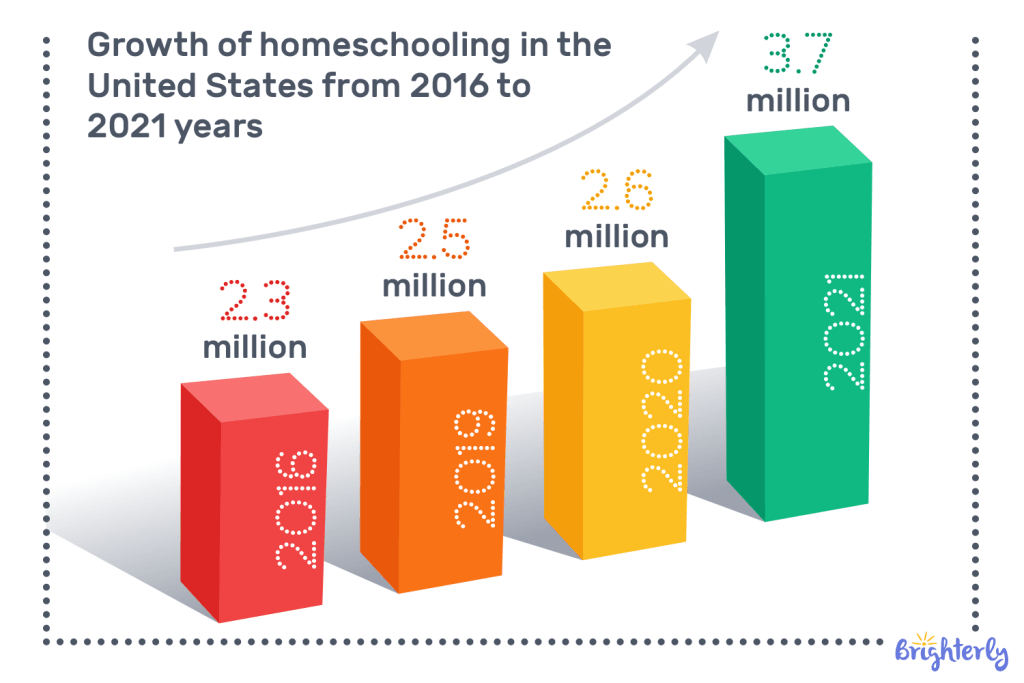
According to the National Home Education Research Institute (NHERI), from 2016 to 2021, the growth rate of the popularity switching to homeschooling in the United States increased quite strongly – from 2.3 million in 2016 to 3.7 million children in 2021.
The institute’s data also shows that from late March to early May 2022, 5.22% of all school-age children were homeschooled. The compound annual growth rate (CAGR) of homeschooling in those years (2016-2021) was 10.1%.
As per the Census Household Pulse survey, the COVID-19 pandemic has had a significant impact on homeschooling rates between March 2020 and the same month in 2021. Data from this survey show that the number of homeschooling households doubled during the pandemic.
Homeschool rates by year: 2022 – 2025
Percent of homeschooling in America from 2022 to 2025 according to NHERI, Education & the Workforce, and other resources.
Homeschooling statistics 2025 |
Homeschool statistics 2024 |
Homeschooling statistics 2023 |
Homeschooling statistics 2022 |
| 3.7 million | 3.7 million | 2.7 million | 3.1 million |
In 2022, after the heat of the pandemic had died down, we saw a decline in the number of homeschooling children. The figures for 2023 show the same thing.
But already in Homeschooling statistics 2024 – 2025, we see that the figure has risen again to the level of 2021, which tells us that the level of homeschooling popularity is still there, even after the pandemic, and is going to grow.
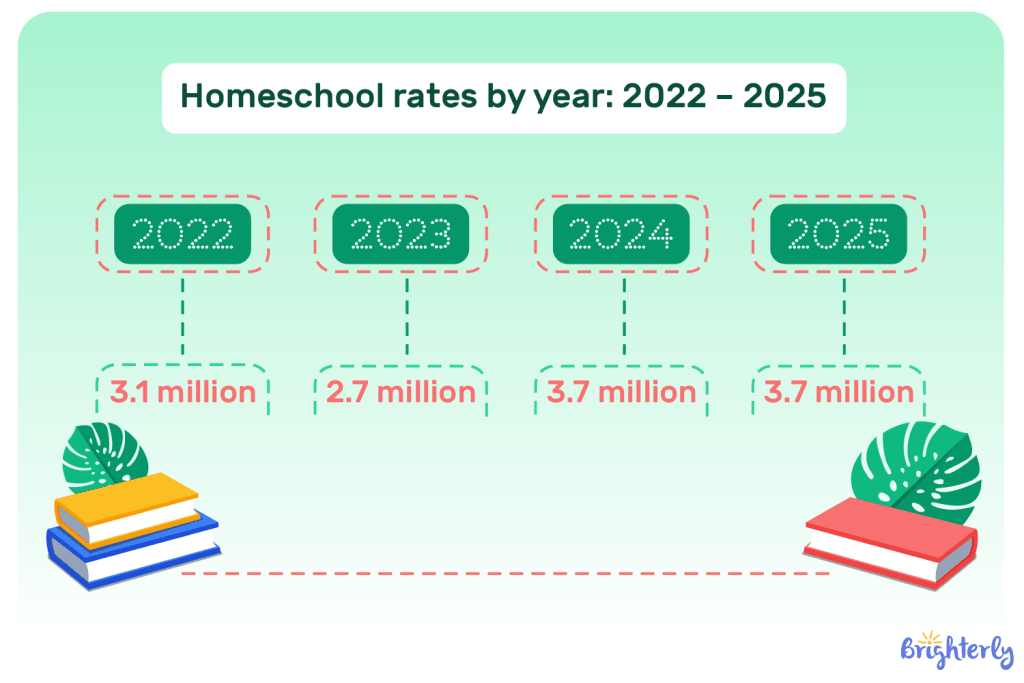
States with the most homeschooling students in 2025
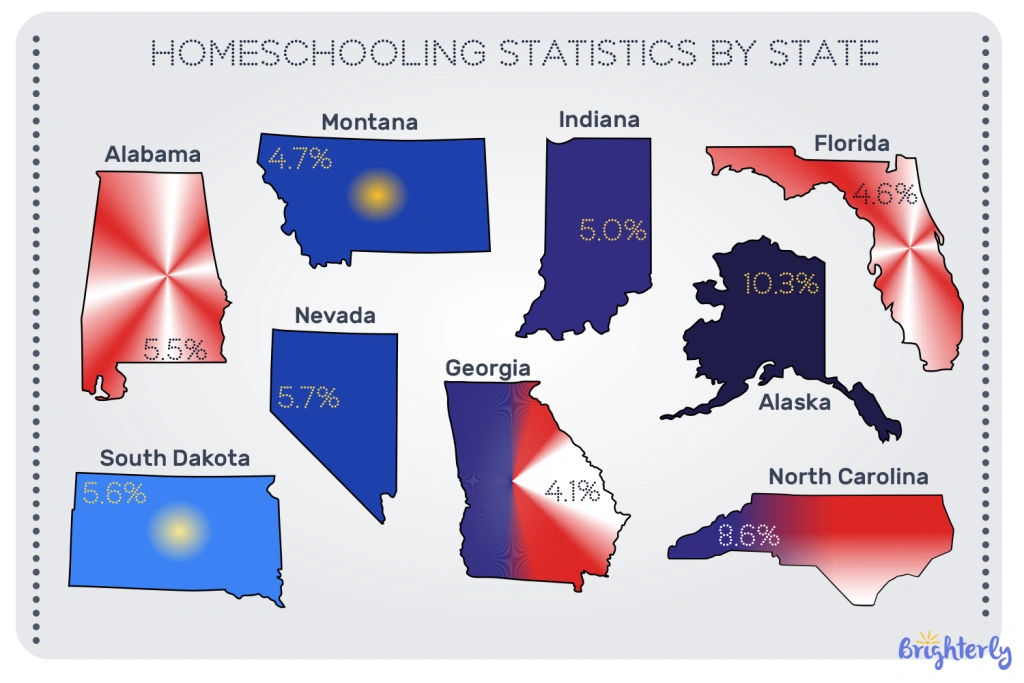
Detailed homeschooling statistics 2025 by state from Edchoice
- Which state has the most homeschoolers
- What state has the most homeschoolers? Infographic
- Percentage of homeschoolers 2025 vs Traditional Public School
- Homeschool vs public school statistics: details
Which state has the most homeschoolers
According to the latest percentage of homeschoolers by state data from Edchoice, the top 3 states with the highest number of homeschoolers in US are Alaska, North Carolina, and South Dakota.
What state has the most homeschoolers? [Infographic]
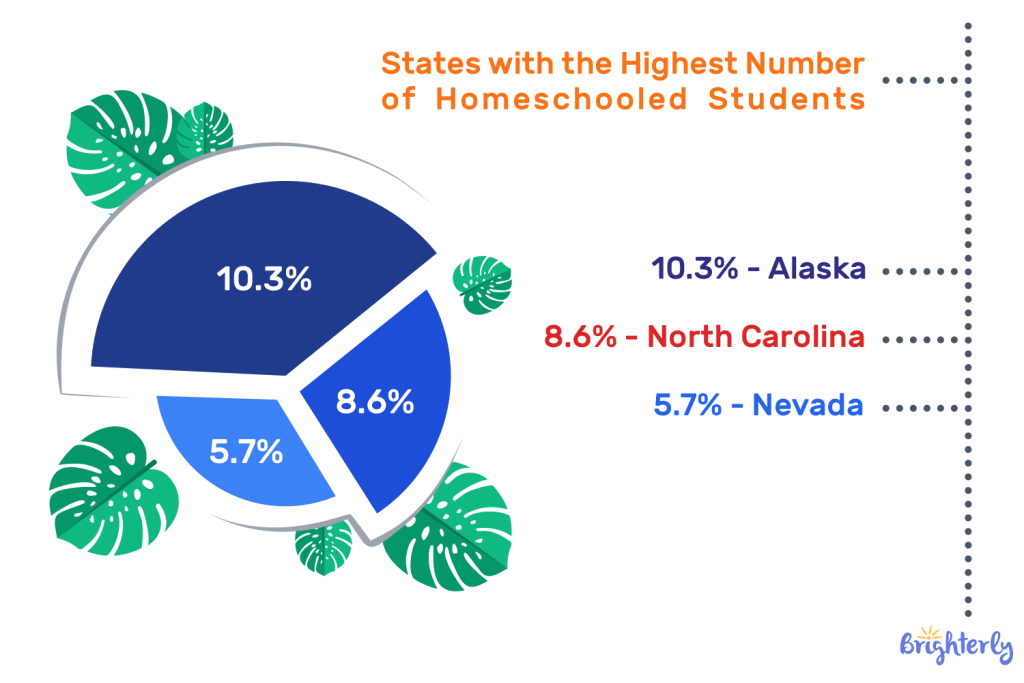
While more than 10% in Alaska and almost 9% in North Carolina prefer this kind of educational choice, in other states, it is from 4 to 6% in general. This is a good indicator, but as we can see from the Edchoice data, traditional public schools are leading the way among other educational choices, and this is quite reasonable because some states have strict rules for the right to switch a child to homeschooling, such as Washington.
Percentage of homeschoolers 2025 vs Traditional Public School

Homeschool vs public school statistics: details
Because of the strict rules, in particular, in Washington, the rate of homeschooled students is only 2.4, not 10 as in Alaska.
It’s easier to set up homeschooling in Alaska. There, parents of students aged 7 to 16 who wish to homeschool are not required to notify the state of Alaska of their intention. The homeschooling law doesn’t require any special qualifications, number of hours of instruction, or curriculum from parents. Parents can choose to homeschool their child with the help of a tutor or a private school, but these options have different requirements.
But as you can see in the table, it is difficult to find at least one state where there are no homeschooled children, which means a lot of US families are choosing this method of education. Why? Let’s take a look below 👇
Reasons for the high success rate of homeschooling in 2025
- Safe Environment
- Homeschool Success Rates
- Religious Education
- Personalized Education Program
- Flexibility in the Schedule
Statistics for homeschooling: reasons for choosing
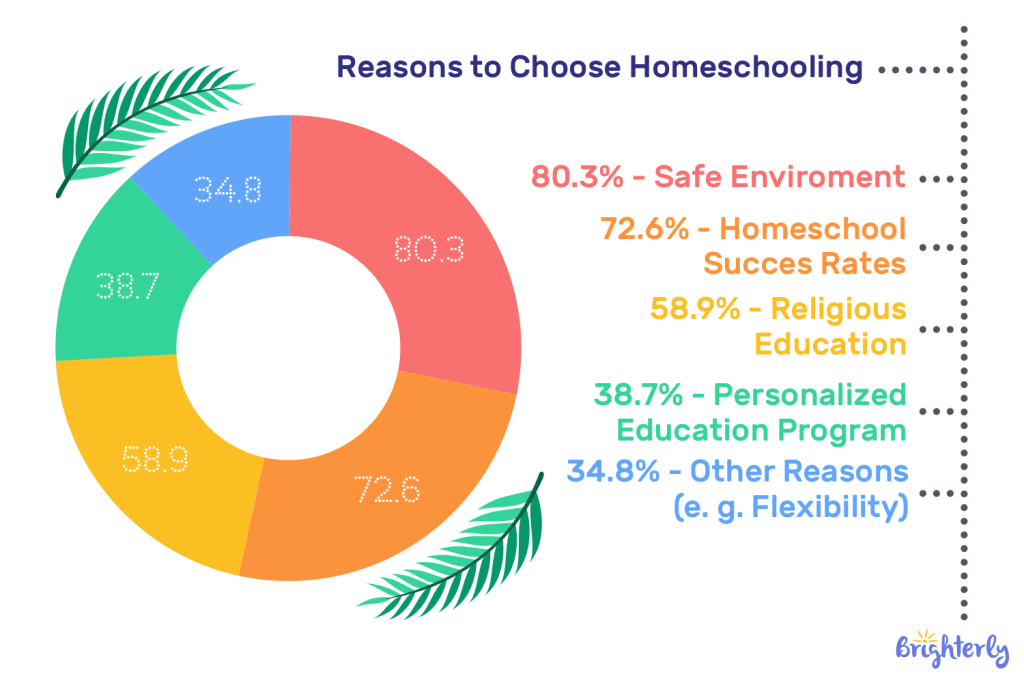
Note: Here are major reasons for switching to partial or full homeschooling according to homeschooling stats from the National Center for Education Statistics (NCES) and our experts from 2022 to 2025. Read more about each reason below.
Homeschool percentage by state grows due to safe environment for schoolers
According to homeschooling statistics, 80% of parents said that the main reason for homeschooling is concern about a safe environment.
Although traditional schools are at the pinnacle of academic learning, it’s hard to say that they’re completely safe for all kids. More often than not, kids get bullied or harassed by their peers and even academic staff. In some cases (such as with special needs children), they may not get all the support they need from school.
This explains why many parents choose to take matters into their own hands by homeschooling their kids. With homeschooling, you can ensure your child’s safety and create a safe space for them to learn.
Homeschooling percentage by state grows due to homeschool success rates
About 72.6% of parents mentioned the poor academic quality and teachers’ approaches in public schools as the primary reasons for homeschooling.
Dr. James A. Barham, an education expert and the Senior Vice President of Academic Influence:
“Many parents are concerned about the quality of education in traditional schools.”
Homeschool success statistics
According to the study of success in adulthood and college in the publication “A Systematic Review of the Empirical Research on Selected Aspects of Homeschooling as a School Choice,” one block can be highlighted:
| What are the statistics on homeschooling success? Eleven of the 16 (69%; studies on success into adulthood and college) showed positive outcomes for the homeschooled compared to those in conventional schools. One study found positive outcomes for conventional school students compared to homeschooled students. Finally, four of the studies found no significant difference between those from homeschool backgrounds and the others from institutional school backgrounds. |
Homeschool success statistics: for individual academic subjects
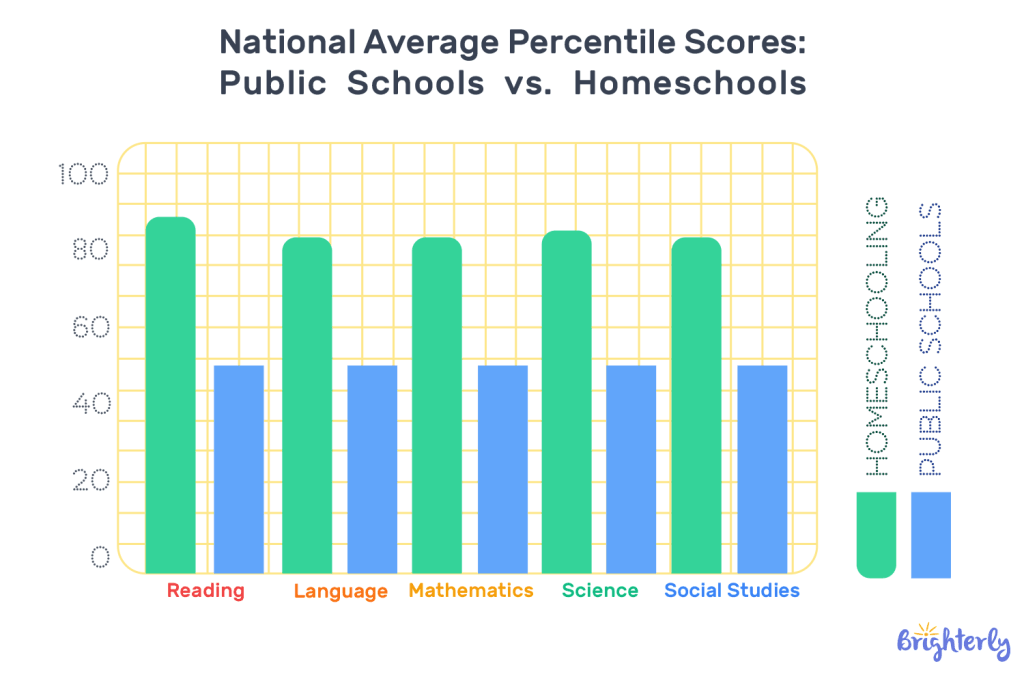
Religious education
According to the homeschooling statistics, 58.9% of the answers were in favor of religious education.
- Many parents chose to educate their kids at home because they wanted to provide and integrate religious instruction into their child’s curriculum.
- For some children, such as Muslims, their religion requires them to pray several times a day. In most public schools for children aged 6 to 12, there is no place where a child can spread a prayer carpet.
- Some religious private schools can be very expensive or located far from home. So in such cases, homeschooling may also be preferred.
Percentage of homeschoolers in US grows due to personalized program
Another 23.1% said that the reason for homeschooling was the child’s special needs, and 15.6% of parents said that the child had a physical or mental problem. This can be about all sorts of things, from health and emotional state to the child’s individual goals. Unfortunately, most public schools cannot boast of an individualized approach.
So, these answers and the percentages of parents can be added up and give personalized learning a well-deserved figure in homeschooling stats – 38.7%.
Remember, traditional schooling may work for most parents, but it certainly has a few drawbacks. For instance, teachers in charge of large classes rarely pay special attention to each child’s specific learning needs. This causes many kids to lag in class, while their needs go unaddressed.
Note: Every child learns differently. Unfortunately, conventional schools don’t recognize or cater to these differences. With homeschooling, you get to provide your child with the type of education they need. You can tailor lessons to meet their needs and fill any learning gaps.
Abid Salahi, Co-founder of FinlyWealth, believes that in the duel between the advantages of public school vs. homeschool statistics, it is obvious that there are enough benefits of homeschooling, in particular, the ability to provide an individualized approach to learning:
“One of the most significant factors behind parents choosing to homeschool by 2024 is their desire for a more customized education for their children based on their needs and learning styles.”
For example, here is a personal case. I am personally close friends with a woman whose son had severe dyslexia and could not learn in a traditional classroom environment. When they decided to homeschool him, the curriculum, pace, and methods used could be truly customized to his special needs, and they produced astounding results. His grades got so much better that his confidence had never been higher
Flexibility in the schedule
According to homeschooling stats from the National Center for Education Statistics, 34% of parents cited other reasons, including flexibility in the schedule.
Unlike traditional schooling where you have to follow rigid rules set by the school, homeschooling is very flexible. As a homeschooling parent, you can make your own choices. You’ll be able to create your own curriculum and schedule. The best part? With homeschooling, learning isn’t limited to school hours.
When your child homeschools, there’s less commuting time and more time spent at home. Generally, homeschoolers complete all their work earlier in the day, too.
Walker Larson, a Literature Teacher at Providence Academy La Crosse:
“Homeschooling education gives more time for family interaction and bonding.”
Here you can watch the story of American commentator Brett Cooper, who studied at an online school and was part of the percentage of homeschoolers in the past. By the way, the first thing she mentioned among the advantages is flexibility, prioritizing learning in the direction of her strengths, and quality time spent studying and with parents.
To summarize: Simply put, according to homeschooling statistics, the main reason why parents choose to homeschool is that they want to provide a safe learning environment for their children. In second place is dissatisfaction with the existing academic system, and religion is another major reason for homeschooling. More about the pros and even cons of homeschooling read here.
Which grade has the most homeschoolers?
According to the National Center for Education Statistics (NCES), the highest number of homeschoolers by state is among students in grades 6 to 8. In 2012, the dominant homeschooling grades were 9-12. However, this trend has shifted in recent times.
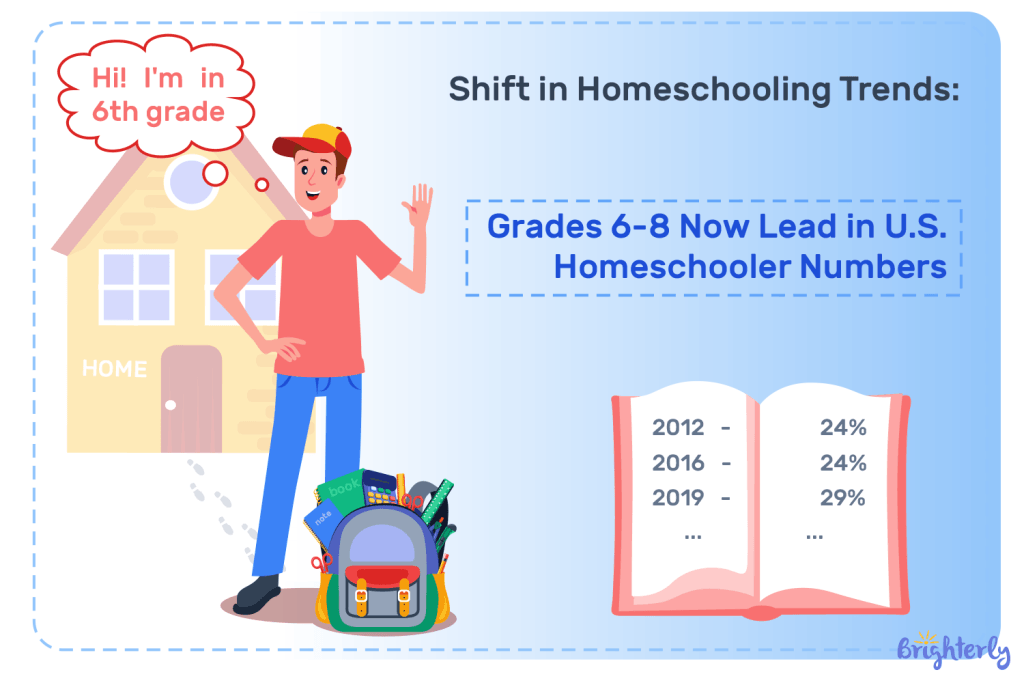
How many homeschool kids in the US?
Around 3.1 to 3.7 million children in the United States are homeschooled, which is about 6-7% of all school-age kids.
How many kids are homeschooled by grade? |
How many kids are homeschooled by grade? |
Percentage of homeschoolers 2016 |
Percentage of homeschoolers 2019 |
| Kindergarten | 12% | 11% | 8% |
| Grades 1 to 3 | 20% | 18% | 22% |
| Grades 4 to 5 | 15% | 17% | 18% |
| Grades 6 to 8 | 24% | 24% | 29% |
| Grades 9 to 12 | 29% | 31% | 22% |
In general, the grade distribution seems to be roughly even across all grade levels above kindergarten.
Homeschooling statistics 2025: Trends by Family Size
Here’s an exciting homeschooling U.S. statistics: up to 48% of homeschooling households have up to 3 or more children. About 33% of homeschooling households have 2 children, while only 19% have 1 child.
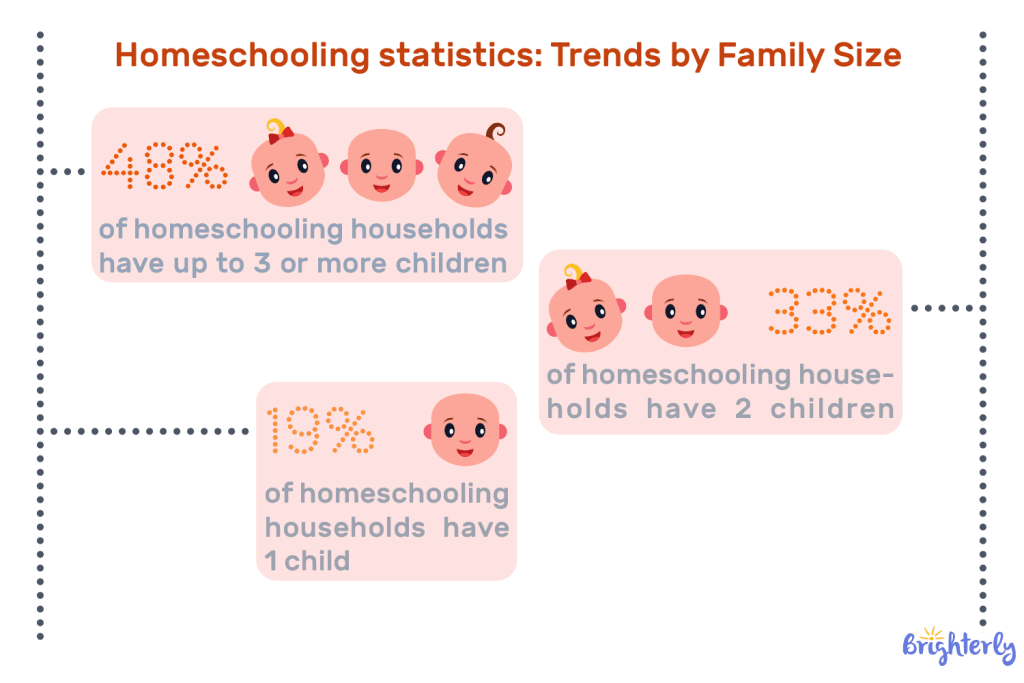
While this data is mind-blowing, it puts an interesting perspective on the homeschooling concept. One may say that it’s easier to homeschool in a household with more than two kids since there’s already a higher focus on kids. Thus, the more kids you have, the more likely you are to go down the homeschooling path.
|
3+ Children |
2 Children | 1 Child |
| 48% of households | 33% of households | 19% of households |
Similarly, NCES’ statistics for homeschooling data also show that 83% of homeschooled students live in two-parent households.
Homeschooling vs Public school statistics and average cost
Several studies and surveys have shown that homeschooling is significantly cheaper than public schools. Estimates for homeschooling in the U.S. typically range from about $500 to $2,500 per child per year, depending on curriculum, materials, and extracurriculars. By comparison, public schools cost parents on average around $1,000-1,500 per pupil, with $577-$1,223 a year spent on school supplies only. For private schools, average tuition is about $32,351 – $71,715 per year for the 2024–25 school year.
The average cost of homeschooling
Category |
Homeschool rates 2025 |
| Curriculum | $350 – $750 |
| Supplies & materials | $150 – $300 |
| Field trips | $100 – $250 |
| Extracurriculars | $100 – $500 |
| Total | $700 – $1,800 |
Statistics on homeschooling: cost in states
According to the data from Alaskawatchman, Homeschooler Pro, The Official State of Nevada Website, Home School Legal Defense Association, Phoenix Home ED, Great Homeschool Conventions, costs in states with the most homeschoolers look like this:
Homeschool rates 2025 in Alaska |
Around $2,000 per school year (Funds can be provided to parents) |
Price for homeschooling in North Carolina |
Around $200 to $400 per school year |
Homeschool rates 2025 in Nevada |
Around $5,000 per school year (Funds can be provided to parents if they qualify for ETV) |
Price for homeschooling in South Dakota |
Around $300-500 per child per year |
Homeschool rates 2025 in Alabama |
Around $50 to over $500 per student annually |
Homeschooling in Indiana |
Around $300–500 per student |
Homeschool rates 2025 in Montana |
More than $500 per school year |
Price for homeschooling in Florida |
Around $700 – $1,800 per student |
How much does it cost to homeschool in Georgia |
Around $500 and $2,500 per student |
Valerie de la Rosa, Educational Coach, Leader, Innovator:
“Homeschool funds are a treasure. ”
College resume building. My eldest niece has a 4.87 GPA because she takes dual-enrollment courses at the local community college. She can take classes any time of day because of her flexible schedule.
Homeschool statistics: income of homeschooling families
According to NHERI’s studies and statistics on homeschooling:
- 34% of homeschooling households have a combined annual income of over $100,000
- 15% of homeschooling households have an annual income of $75,001 to $100,000
- 21% of these households make between $50,001 to $75,000 each year
Average income of homeschooling families [Inpographic]
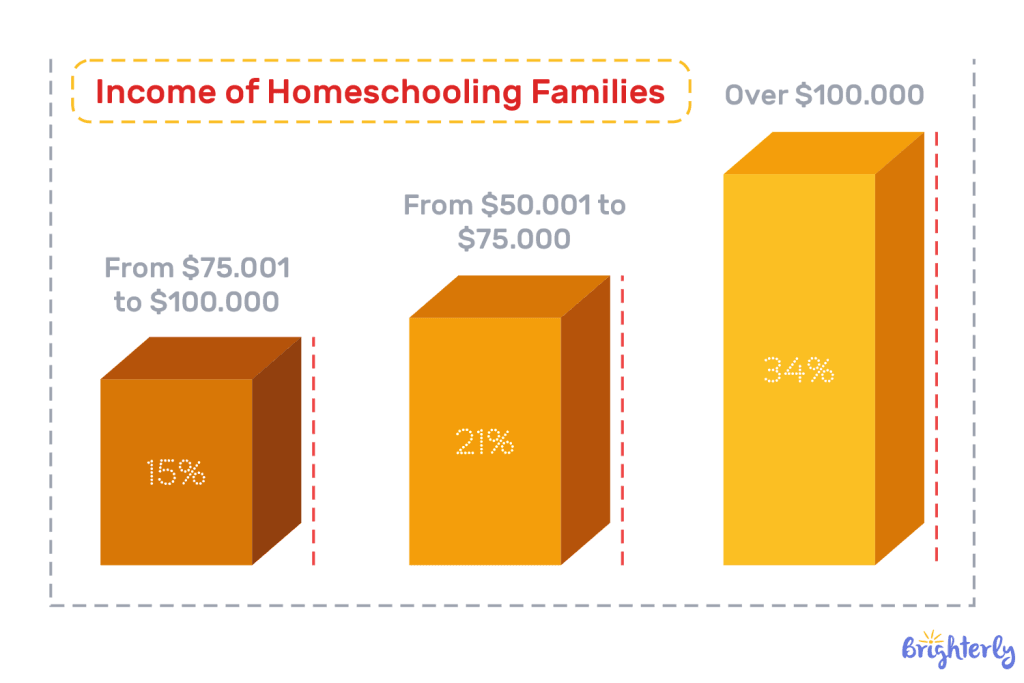
Conclusion
Homeschooling can be either full or partial. For the first option, parents need to familiarize themselves with the rules of switching to this education type in their state. Each state has its own requirements.
Homeschooling has been on the rise in recent years and from all indications, this trend will continue in 2025. Homeschooling stats show that there are more than 3 million homeschooled children in the United States.
Why do so many parents choose this education for their children?
- They want personalized learning,
- The child doesn’t waste time learning information they don’t need,
- The learning program is focused on what the child is good at,
- And safety.
Whether it’s full-time homeschooling or part-time (there are online after-school classes, for example), at Brighterly, we can find the perfect math tutor for your child – according to their age, personal characteristics, and needs. Our tutors apply a personalized approach to each student and engage students’ interest in this academic subject through interactive lessons and qualifications. Join now and get 1st free lesson.

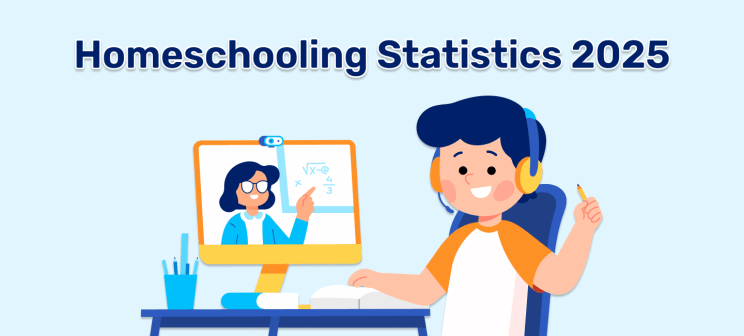





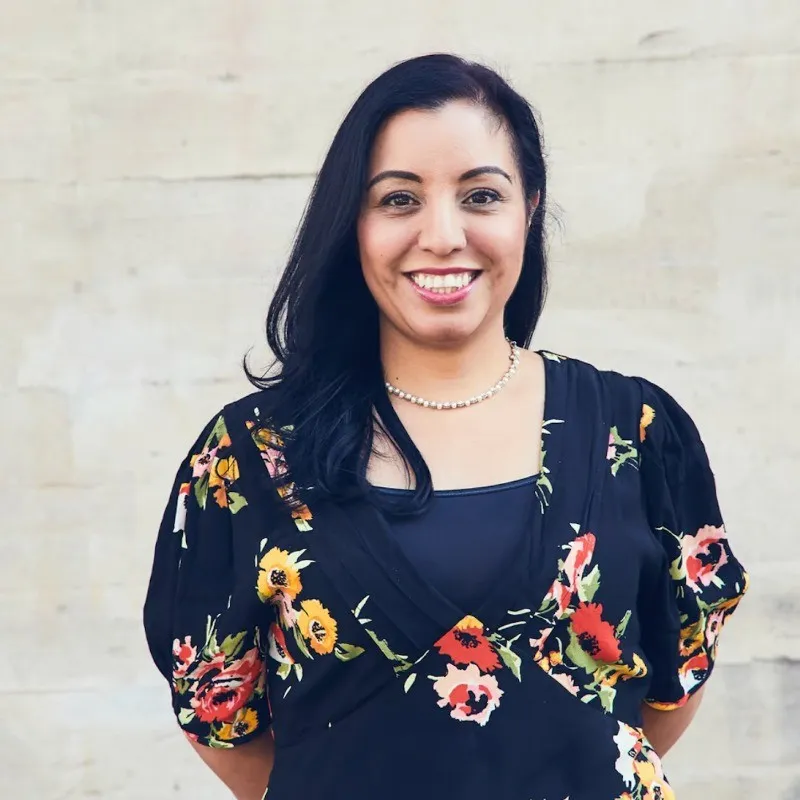






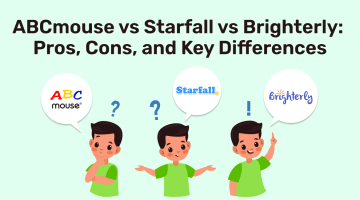

![Kumon Reading Reviews: Is It the Right Choice? [2025]](https://brighterly.com/wp-content/webp-express/webp-images/doc-root/wp-content/uploads/2025/06/Kumon-Reading-Reviews-1-e1751285514847-360x200.png.webp)


